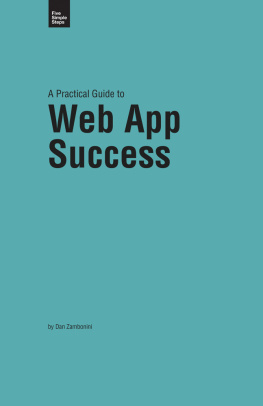Cover

A Practical Guide to Web App Success
by Dan Zambonini
Published in 2011 by Five Simple Steps
Studio Two, The Coach House
Stanwell Road
Penarth
CF64 3EU
United Kingdom
On the web: fivesimplesteps.com
and: www.danzambonini.com
Please send errors to
Publisher: Five Simple Steps
Editor: Owen Gregory
Production Editor: Sarah Morris
Art Director: Nick Boulton
Designer: Colin Kersley
Copyright 2011 Dan Zambonini
All rights reserved. No part of this publication may be reproduced or transmitted in any form or by any means, electronic or mechanical, including photocopy, recording or any information storage and retrieval system, without prior permission in writing from the publisher.
ISBN: 978-0-9561740-3-1
A catalogue record of this book is available from the British Library.
Foreword
Mark Boulton
Ideas are cheap.
And so are web apps.
Only ten short years ago, it was hard to release a web-based product. Servers were expensive and ubiquitous connectivity was something many of us dreamt of. The always connected people were having lives elsewhere. It was a very different place.
Then, along came 37Signals and Basecamp and things started to change. Yes, there were others before them. But because of the people they knew, the conferences they spoke at, and the desire to keep things simple, 37Signals inspired a generation.
Very suddenly, creating web apps was not a dream for many people. 37Signals made people believe anyone could do it. And many have. The Web 2.0 movement of a few years ago along with its horrible logos and acronyms - encapsulated a change on the Web. A change from static brochures, to complex and rich applications. Web applications. That was 2005.
Since then, the Web and how we use it has changed. In 2005, I used Apple Mail (pop) for my email and iCal for my calendar. I used Microsoft Office for writing documents and spreadsheets. I backed up my files to a server every night. My timesheets were recorded on paper. Now, I use Google Docs, Google Calendar, Gmail, Dropbox and Harvest. I use Basecamp to help run my projects. All of these software applications and practices have been replaced by online equivalents.
But these are the success stories. Many web apps have a wonderful birth only to wither and die within a few months. Why? Because ideas are cheap. Creating a product and a business is difficult. Thats where this book comes in.
In this book, Dan Zambonini hasnt written a silver bullet. What hes written through years of research, commercial success and failures is a manual to help you know whats involved. Hes been there and done it. Learnt the mistakes, recorded them here so we can benefit. If youre a designer, developer or entrepreneur kick-starting a web app idea in your spare time, this book will give you a head start.
What does it take to create a successful web app? A good idea?
For the first part sure, but for the rest? Youre holding it in your hands.
Part 1
Groundwork
Chapter 1
Introduction
An informal survey from February 2011 highlighted a variety of reasons why people build web apps, from the lure of financial riches to the hope of improving the world. Whatever your personal motivation and goals, this book will give you the practical, tested, realistic advice necessary to achieve them.

Youll find processes, statistics and resources that you can use for the entire lifecycle of your app, from developing the seed ofan idea to post-launch promotion. Rather than getting bogged down with unnecessary detail and opinion disguised as best practice, this book concentrates on the critical points of each topic to ensure a well-rounded app thats equipped for even the most demanding users.
Whats covered in this book
This opening chapter sets the stage for your project, with an overview of the current state of the web and whos doing what online. The remainder of the Groundwork section guides you through the preparatory stage of your project: what you need to know, do and expect before you dive in.
The Strategy of your app is developed in the second section. A user-centered design approach and early consideration of business models will give your app an advantage over ill-considered competitors, and will set the foundations for long-term viability.
In the third section, your strategy will inform the Interface of the app, helping you create a usable, beautiful user interface that behaves as your customers expect.
The subsequent Development section doesnt discuss programming code in detail, as this broad topic is comprehensively covered in numerous existing books and online resources. Instead, the complexities, considerations, tools and best practice methodologies of technical web development are explained, together with the performance, security and quality of the app.
Once youve developed the first working version of your web app, the Promotion section puts a plan in place to acquire those important first customers, using traditional and modern marketing techniques.
The web app landscape
A web application or web app is a web-based tool specifically designed to help a person perform a task
The web has transformed our daily lives. From mundane grocery purchases and birthday party invitations, to potentially life-changing stock trades and eco-activist grassroots organisation, there are now quicker, cheaper and easier ways to manage our lives online, through web applications.
As connection speeds improve and the webs pervasiveness is further entrenched, we have become increasingly reliant on web apps, and their monetary and cultural value have grown accordingly.
Billions of dollars are spent on commercial acquisitions every year. In 2010, some 62 web start-ups sold for a total of $4.1 billion.
In the first quarter of 2010, over eight million new .com and .net domain names were registered, many of them in the hope of becoming the next multimillion dollar app. At this rate, about five new .com and .net domain names will have been registered since you started to read this sentence.
What makes these applications so valuable?
The market
As of May 2010, almost eighty per cent of the US population uses the web: thats over a quarter of a billion potential customers in one country alone.
The web reaches 28% of the global population (almost two billion people) and its increasing by about the size of the US online population every year. Not only is the current online market larger and more easily reached than any before, future growth will be considerable and as good as inevitable.
The opportunities are vast, and you can build, register and host your app (making it available to almost all of these people) for less than the cost of watching a movie in the cinema every month.
The good news: most apps fail
With substantial potential payouts and negligible start-up costs, its no wonder that so many try their luck. Every week, a steady stream of entrepreneurs pitch their new web app, describe its features and tell you why their application will be The Next Big Thing.
The odds are that most of these apps will fail. Even if you look at the most promising apps each year take the Techcrunch 50 of any given year, for example its unlikely that the majority will turn a profit, be acquired or survive more than a few years. If these were physical businesses that opened on your main street, youd live in a perpetual ghost town. But thats okay.













